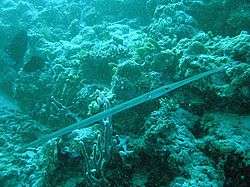Bluespotted cornetfish
The bluespotted cornetfish (Fistularia commersonii), also known as smooth cornetfish or smooth flutemouth, is a marine fish which belongs to the family Fistulariidae. This very long and slender reef-dweller belongs to the same order as the pipefishes and seahorses, called Syngnathiformes.
| Bluespotted cornetfish | |
|---|---|
 | |
| Fistularia commersonii from Maldives | |
| Scientific classification | |
| Kingdom: | Animalia |
| Phylum: | Chordata |
| Class: | Actinopterygii |
| Order: | Syngnathiformes |
| Family: | Fistulariidae |
| Genus: | Fistularia |
| Species: | F. commersonii |
| Binomial name | |
| Fistularia commersonii | |
| Synonyms[3] | |
|
Fistularia depressa Günther, 1880 | |
Distribution
It is widespread in the tropical and subtropical waters of the Indo-Pacific as far north as Japan and east to the coasts of the Americas,[1] including the Red Sea.[3] In 2000, its presence was reported in the Mediterranean Sea; since then, it has continued to disperse and is now well established in some areas.[4] This species is considered as part of the Lessepsian migration.[5] It has spread rapidly through the Mediterranean from its origin in the Suez Canal, the first records being off Israel in 2000 and it had reached the southern coast of Spain[6] and as far north as the Gulf of Lions by 2007.[7] Scientists have determined that the fish in the Mediterranean are all descended from a small number of ancestors, possibly as a result of a single invasion event, and are not as genetically variable as their conspecifics in the Red Sea.[7]
Morphology
The bluespotted cornetfish grows to a length of 1.6 m (5.2 ft), but the average is around 1 metre (3 ft 3 in).[3] It is notable for its unusually long, slender body shape.[4] It has a tubular snout, large eyes and a long tail filament lined with sensory pores which may help with detecting prey. Its body is greenish-grey to brown with two thin blue stripes or lines of dots on the back and lighter on the front.[3] Its body pattern changes to a broad banded pattern at night.[4]
Biology
The bluespotted cornetfish is usually a solitary predator, stalking and feeding on small fishes, crustaceans, and squid.[3] Sometimes, they feed in small groups along the bottom on small, bottom-dwelling fish which their long snouts are very efficient at sucking up. Reproduction is oviparous.[3] The large eggs hatch and develop outside of the body. Larvae hatch at 6–7 millimetres (0.24–0.28 in).
Human relevance
The fish is of minor importance commercially, mostly being sold as fish meal but also fresh and preserved.[4] It is also sold as an aquarium fish.
Name
The specific name honours the French botanist Philibert Commerson (1727-1773).[8]
References
| Wikimedia Commons has media related to Bluespotted cornetfish. |
| Wikispecies has information related to Bluespotted cornetfish |
- Pollom, R. (2016). "Fistularia commersonii (errata version published in 2017)". The IUCN Red List of Threatened Species. 2016: e.T18257780A115368874. doi:10.2305/IUCN.UK.2016-3.RLTS.T18257780A88675577.en.
- "Fistularia commersonii". Integrated Taxonomic Information System.
- Froese, Rainer and Pauly, Daniel, eds. (2018). "Fistularia commersoni" in FishBase. February 2018 version.
- Bray, Dianne; Thompson, Vanessa. "Smooth Flutemouth, Fistularia commersonii". Fishes of Australia. Archived from the original on 23 February 2015. Retrieved 16 September 2014.
- "Fistularia commersonii Bluespotted Cornetfish". Encyclopedia of Life. eol. Retrieved 10 June 2018.
- Domenico Meloni & Pierluigi Piras (2013). "Fistularia commersonii (Syngnathiformes Fistularidae), in the South-Western Mediterranean Sea" (PDF). Biodiversity Journal. 4 (3): 435–438.
- Ernesto Azzurro; S. Soto; Germana Garafolo & Francesc Maynou (2012). "Fistularia commersoniiin the Mediterranean Sea: Invasion history and distributional modeling based on presence only records". Biological Invasions. 15 (5): 977–990. doi:10.1007/s10530-012-0344-4. hdl:10261/83100.
- "Biographical Etymology of Marine Organism Names. C". Hans G. Hansson. Retrieved 10 June 2018.
External links
- DORIS
- Sous les mers
- WoRMS
- Fishbase
- Photos of Bluespotted cornetfish on Sealife Collection
